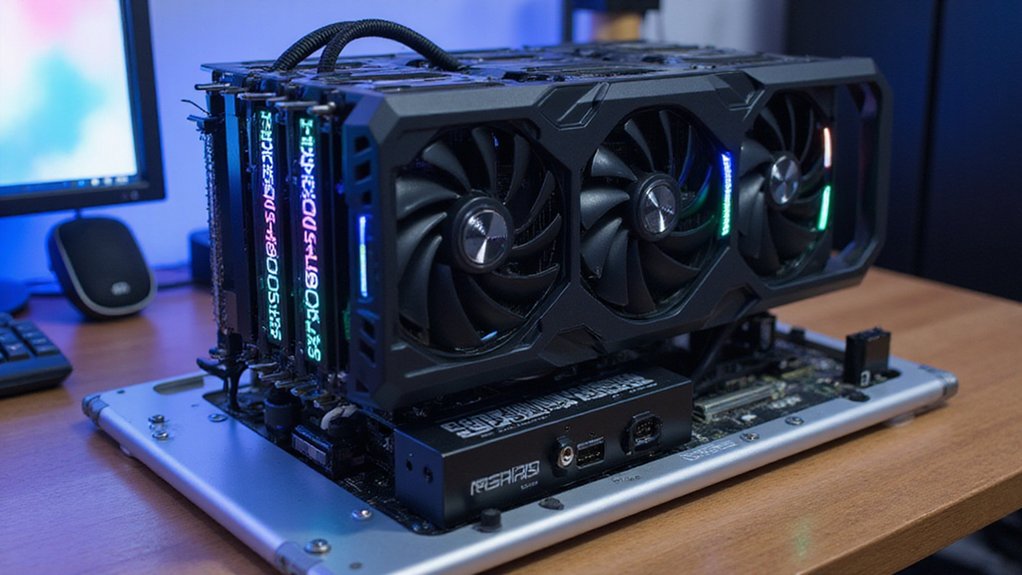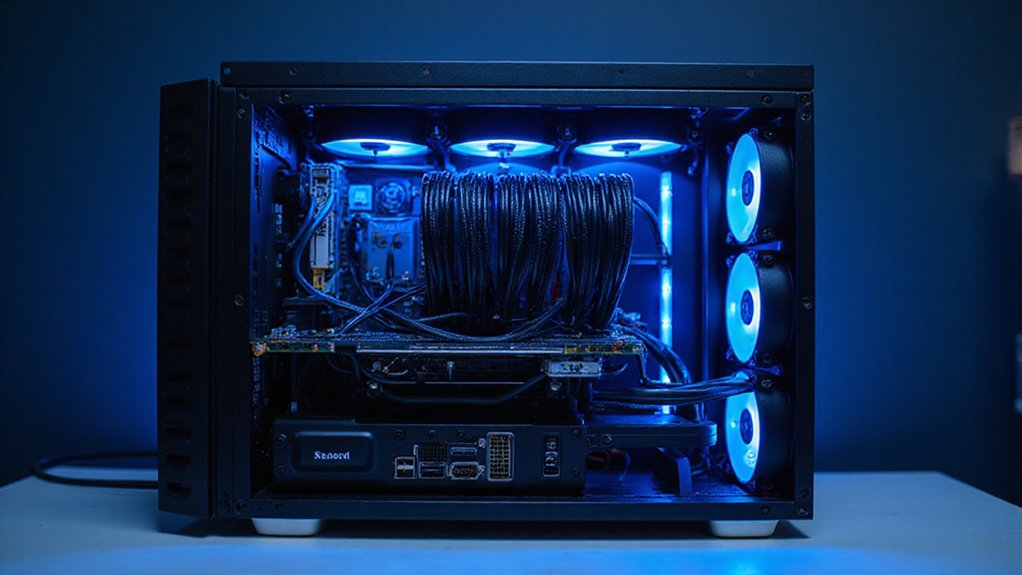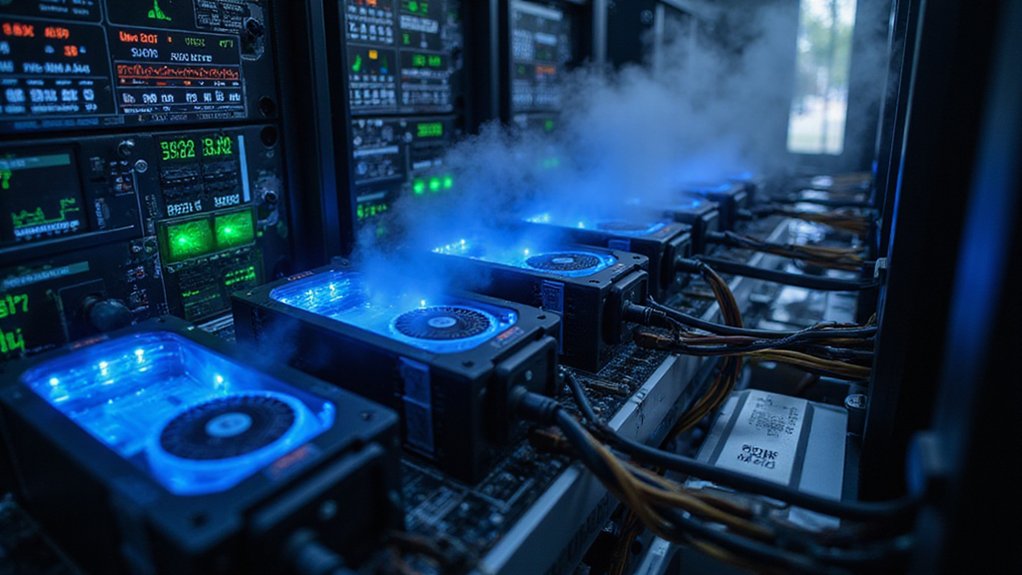Building a crypto mining rig requires strategic hardware selection—typically multiple GPUs (Nvidia RTX 3080 or AMD Radeon RX 6800 XT), a mining-compatible motherboard, and a robust power supply exceeding 1,000W. Assembly involves mounting components and connecting GPUs via PCIe risers, followed by installing a lightweight OS and specialized mining software. Effective cooling solutions and regular maintenance are non-negotiable. The initial investment might seem steep, but proper planning transforms computational puzzles into potential profit.

Why venture into cryptocurrency mining when the market fluctuates with the predictability of a roulette wheel?
Despite the volatility, constructing a mining rig remains an enticing prospect for those willing to navigate the labyrinthine world of digital currencies—a pursuit that demands meticulous planning and technical acumen.
The journey begins with thorough market research to identify profitable cryptocurrencies and their corresponding mining algorithms.
One must allocate budget judiciously, considering not only initial hardware investments but also ongoing electricity expenditures—a factor that frequently devours profit margins with alarming efficiency.
Bitcoin miners secure the network by solving mathematical puzzles that verify transactions and add them to the blockchain ledger.
Space requirements and power availability constitute equally critical considerations in this preliminary phase.
At the hardware core lies the selection of high-performance GPUs—Nvidia RTX 3080 or AMD Radeon RX 6800 XT represent current favorites—mounted on a multi-GPU compatible motherboard (the ASUS B250 Mining Expert stands as an exemplar in this category).
This configuration necessitates a robust power supply exceeding 1,000W, modest RAM specifications (4-16GB DDR4 suffices), and minimal storage requirements (a small SSD for the operating system).
The assembly process follows a logical sequence: motherboard installation, CPU and RAM mounting, GPU connection via PCIe risers, power supply integration, and meticulous cable management.
Thermal regulation presents a paramount concern; effective cooling solutions—whether air-based or liquid systems—must be implemented to prevent hardware degradation.
Software configuration entails installing a lightweight operating system (Linux variants offer maximum efficiency) and appropriate mining software tailored to the target cryptocurrency.
A secure wallet setup completes this digital infrastructure.
The number of GPUs installed directly influences your rig’s hash rate and overall mining efficiency.
Maintenance protocols cannot be overstated: regular performance monitoring, software optimization, hardware cleaning, and power consumption analysis represent ongoing responsibilities.
Safety measures—proper ventilation, surge protection, fire prevention—demand unwavering attention.
The cryptocurrency mining landscape rewards neither the faint-hearted nor the unprepared.
Those who approach this venture with calculated diligence, however, may discover a singular confluence of technological engagement and financial opportunity—provided they possess the fortitude to endure market vagaries and technical complexities alike.
Frequently Asked Questions
Is Crypto Mining Still Profitable in Today’s Market?
Cryptocurrency mining profitability has become increasingly stratified, with individual miners facing prohibitive barriers.
Post-halving economics demand industrial-scale operations, sub-$0.04/kWh electricity contracts, and cutting-edge ASIC hardware to remain viable.
Small-scale enthusiasts (once the backbone of decentralization) find themselves relegated to mining alternatives or hashpower marketplaces—victims of difficulty adjustments and efficiency wars.
The days of basement Bitcoin bonanzas have yielded to corporate mining campuses with diversified revenue streams and regulatory arbitrage strategies.
How Much Electricity Will My Mining Rig Consume?
A typical mining rig’s electricity consumption varies dramatically based on its configuration.
A standard three-GPU setup typically consumes approximately 1,000 watts while operating—potentially translating to 720 kWh monthly at full utilization (though the 80% utilization rate commonly observed would adjust this figure downward).
This consumption, which can easily rival that of multiple major household appliances operating simultaneously, represents a significant operational cost that prospective miners frequently underestimate when calculating potential profitability.
Can Mining Damage My Computer Components Over Time?
Cryptocurrency mining can indeed accelerate component deterioration through several mechanisms.
The constant computational strain places GPUs and CPUs under perpetual stress, while excessive heat generation—a notorious byproduct of mining operations—further compromises longevity.
Power supplies, often overlooked, may fail prematurely when continuously pushed to their limits.
Additionally, cooling systems working overtime can themselves wear out, creating a cascade of potential hardware failures.
Even with ideal cooling, the relentless workload inevitably shortens component lifespan compared to typical usage patterns.
Are Some Cryptocurrencies Easier to Mine Than Others?
Yes, cryptocurrencies vary dramatically in mining accessibility.
CPU-friendly coins like Monero (using RandomX) remain viable for modest setups, while Bitcoin’s SHA-256 algorithm has spawned an arms race of specialized hardware virtually requiring institutional investment.
Memory-light algorithms (X11) accommodate mid-tier GPUs, while ASIC-resistant protocols (KAWPOW) deliberately level the playing field.
Network size further stratifies the landscape—smaller networks like Ravencoin present substantially less competition than their blue-chip counterparts, where solo mining has become something of a quixotic endeavor.
What Are the Tax Implications of Crypto Mining?
Crypto mining creates immediate tax obligations—rewards are ordinary income at fair market value upon receipt, with subsequent sales triggering capital gains or losses.
The IRS’s classification (business vs. hobby) determines deductibility of equipment and operational expenses.
Business miners enjoy deductions via Schedule C but shoulder self-employment taxes, while hobby miners report income without substantial write-offs.
Rigorous record-keeping proves essential for compliance, as the IRS views undocumented crypto activities with predictable skepticism.
Failure to report carries significant penalties.









